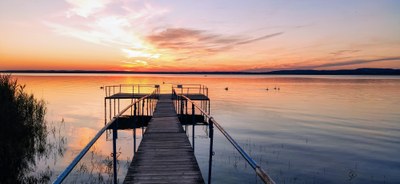All official European Union website addresses are in the europa.eu domain.
See all EU institutions and bodiesWater sustains every aspect of our lives — from the health of our citizens to the productivity of our industries and the health of our natural environment. From extended droughts and pollution to mounting demand and inefficient use, our freshwater systems are under unprecedented stress. How can we ensure that we continue to have access to sufficient amounts of clean water in the future?
Pollution, habitat degradation, impacts of climate change, and the over-use of freshwater resources are putting significant pressure on Europe’s lakes, rivers, coastal waters and groundwaters, as concluded in our report ‘Europe’s state of water’.
Seasonal water scarcity already affects around 30% of the EU’s land area each year. In May 2025 alone, approximately 39% of the total area of EEA 38 member and cooperating countries experienced drought conditions. Floods are also having increasing impacts, sometimes resulting in loss of lives. Water abstraction — the removal of water from its natural source for use — remains high, particularly in agriculture, energy production, public water supply and manufacturing. At the same time, harmful pollutants such as nitrates, pesticides, and PFAS, are accumulating in water bodies, posing risks to human health and aquatic ecosystems.

To respond to these challenges, on 4 June, the European Commission published the European Water Resilience Strategy. As Commissioner for environment, water resilience and a competitive circular economy, Jessika Roswall, stated, “With the European Water Resilience Strategy we give Member States the necessary toolbox to fix our broken water cycle, to become a water-smart economy and to ensure clean and affordable water for everybody. Our future depends on how well we start managing our water today.”
This policy framework was further strengthened by the adoption of the European Ocean Pact on 5 June, which offers a comprehensive strategy to better protect the ocean, promote a thriving blue economy and support the well-being of people living in coastal areas.
The importance of connecting inland water management with ocean health was further highlighted by European leaders at the 2025 UN Ocean Conference held in Nice, also in June. This connection is not symbolic — it is strategic and global. Rivers, lakes and groundwater systems are essential to restoring the health of our oceans.
Reduce, reuse, diversify and restore
Strengthening water resilience requires a comprehensive approach. Following the 'water efficiency first' principle, our first priority should be to reduce abstraction and improve efficiency. It is also clear that we must also diversify water supply sources. Reuse, desalination, and rainwater harvesting can provide vital back-up during droughts.
The EU’s Water Reuse Regulation offers a framework to ensure reclaimed water is safe for irrigation and potentially other uses in future. Treated wastewater can become a resource for agriculture and can replace water abstracted from surface or groundwater. Member States such as Cyprus and Malta already reuse 90% and 60% of their treated wastewater, respectively. Yet EU-wide, water reuse still accounts for just 0.3% of total abstraction — a huge untapped opportunity.
Desalination, while energy-intensive, is also expanding, especially in Mediterranean countries, and is increasingly viable when paired with renewable energy and implemented in ways that minimise the impacts of brine effluents on marine ecosystems. Rainwater harvesting is another sustainable option, already in use from airports in the Netherlands to green spaces in Poland.
Restoration of rivers, wetlands and peatlands can lead to healthier, more biodiverse and resilient ecosystems, capable of storing and supplying good quality water, storing carbon and mitigating the impact of extreme weather events.
Savings in four sectors key to water resilience
Europe is the fastest-warming continent, as our European climate risk assessment found. Not having enough freshwater will affect us, nature and the economy alike. It can result in lower crop yields, higher energy prices, declining ecosystems, and deeper social inequality.
Our recent briefing, Water savings for a water-resilient Europe, highlights how critical water efficiency will be in responding to this risk. The European Water Resilience Strategy sets an EU-wide target to enhance water efficiency by at least 10% by 2030 and encourages Member States to set their own targets, based on their national circumstances.
The EEA briefing identifies four sectors — agriculture, electricity production, public water supply, and industry — that together account for 98% of water abstracted by economic activity. These sectors also offer substantial potential for savings.
In agriculture, for example, water use can be reduced by up to 20% through a combination of modern irrigation methods, improved distribution infrastructure, and smart farming practices. Solutions already exist, such as Italy’s IRRINET system, which integrates crop monitoring and decision support to optimise irrigation schedules, cutting water use without compromising yields.
In the energy sector, as the EU transitions towards renewable energy sources, reliance on water-intensive cooling systems is expected to decrease. Technical upgrades and the adoption of alternative cooling methods could reduce water abstraction in the sector by up to 95%.
In the public water supply, the focus is on addressing infrastructure-related losses. On average, around one-third of treated water is lost before reaching end users. Programmes such as Ireland’s National Leakage Reduction Programme have demonstrated that systematic investment in repairs and upgrades can deliver measurable reductions — from 46% leakage in 2018 to 38% in 2021 — with further improvements planned.
Industry also presents clear opportunities. Through water recycling, reuse, and process optimisation, some manufacturing sectors have achieved water use reductions of 30–50%. In Belgium, for instance, breweries have successfully implemented such measures, combining environmental benefits with economic gains. As the climate warms and new sectors like hydrogen production and data centres place additional pressure on water resources, a diversified approach will be essential.
Data and knowledge to underpin our actions
Water is precious, unpredictable and variable. We need better information on where water is used, lost, or wasted — especially considering growing seasonal variability and emerging economic demands. For our actions to be effective, we will continue to need reliable data to monitor progress and assess the status of our water bodies.
This September we will be publishing our five-yearly flagship report, Europe’s environment 2025, which will provide a comprehensive analysis of and the interlinkages between the challenges we face, including climate change and water resilience.
With its comprehensive and integrated policy framework, supported by solid data and coordinated efforts, Europe can boost its water resilience — and protect people, strengthen the economy and sustain the natural systems we all depend on.









